You can create an effective chemical-free bug spray by mixing equal parts apple cider vinegar and water in a spray bottle, then adding 2-3 drops of liquid dish soap. This non-toxic solution disrupts insects’ sense of smell while the acetic acid kills pests on contact, making it particularly effective against ants and fruit flies. Apply it around entry points and reapply every few hours for maximum protection. Continue below to discover proper storage methods and application techniques for ideal results.
Understanding Apple Cider Vinegar as a Natural Pest Deterrent
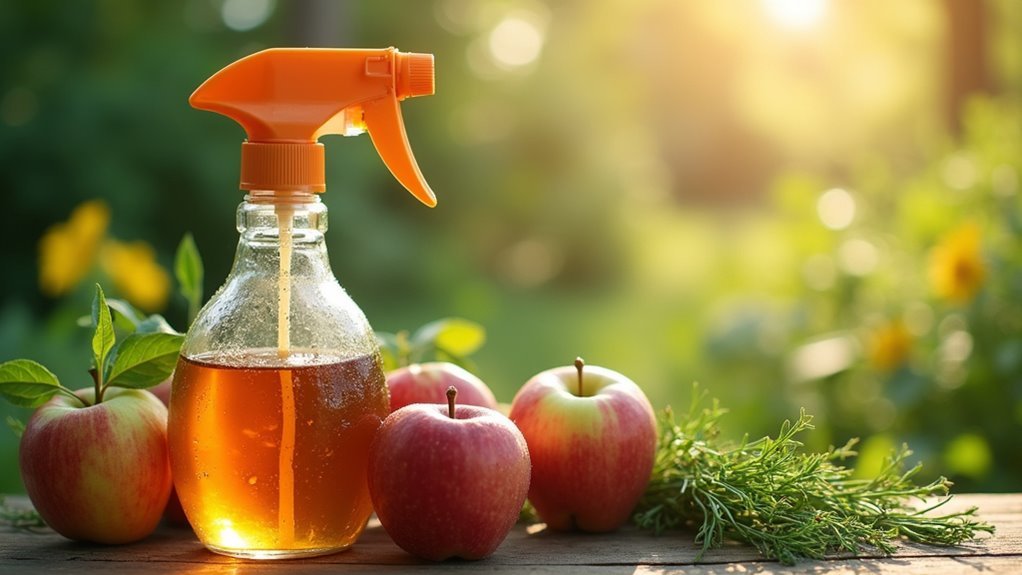
When you’re searching for a safe alternative to chemical pesticides, apple cider vinegar emerges as a powerful natural pest deterrent that’s both effective and non-toxic.
This common household ingredient works by disrupting insects’ sense of smell through its strong odor, making treated areas less attractive to unwanted visitors.
The secret lies in apple cider vinegar’s acetic acid content, which can kill pests upon contact while simultaneously repelling others.
You’ll find it’s effective at repelling insects like ants and fruit flies when applied consistently around entry points where pests commonly appear.
Creating your own homemade bug spray is simple—just mix equal parts apple cider vinegar and water.
This non-toxic solution provides excellent pest control while keeping your family and pets safe from harmful chemicals.
Essential Ingredients for Effective Apple Cider Bug Spray
Now that you understand how apple cider vinegar works as a natural pest deterrent, you’ll need to gather the right ingredients to maximize your homemade bug spray’s effectiveness.
The foundation starts with equal parts apple cider vinegar and water, creating a potent natural insect repellent that’s safe to use around your family and pets.
Mix equal parts apple cider vinegar and water for a safe, family-friendly natural insect repellent that really works.
Adding liquid soap enhances your spray’s ability to repel bugs by breaking down insects’ protective exoskeletons. Just a few drops will make your mixture more effective without compromising its natural properties.
The vinegar’s acidity provides dual benefits – it disrupts pests’ sense of smell while offering antibacterial protection for your plants.
These simple ingredients combine to create one of the most effective homemade bug sprays available, delivering chemical-free protection for your home and garden.
Step-by-Step Recipe for Indoor Apple Cider Pest Control
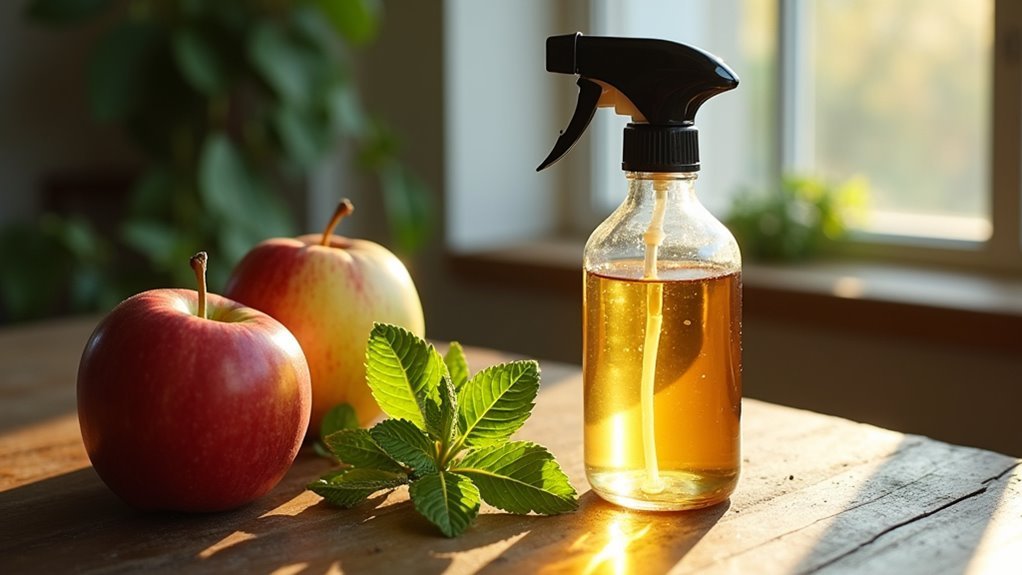
You’ll need to follow precise ingredient ratios and mixing steps to create an effective apple cider bug spray that actually repels pests.
The preparation process requires specific techniques to guarantee the solution maintains its potency throughout use.
Proper application methods and storage practices will maximize your spray’s effectiveness and extend its shelf life.
Essential Ingredients and Ratios
Creating an effective apple cider bug spray requires just three simple ingredients that you likely have in your kitchen right now. This chemical-free solution harnesses apple cider vinegar’s potent odor to disrupt insects’ ability to navigate through smell. You’ll need equal parts apple cider vinegar and water, plus a few drops of liquid dish soap for enhanced effectiveness.
Essential ingredients and their ratios:
- Apple cider vinegar – 1 part (creates the primary insect-repelling barrier)
- Water – 1 part (dilutes the mixture for safe application)
- Liquid dish soap – 2-3 drops (improves adhesion and breaks surface tension)
- Spray bottle – 1 clean container (ensures even distribution)
- Cool storage location – maintains potency for months
This non-toxic homemade spray effectively reduces insect activity while keeping your household safe from harmful chemicals.
Mixing and Preparation Steps
Five simple steps transform your basic kitchen ingredients into a powerful pest control solution.
First, pour equal parts apple cider vinegar and water into your spray bottle, creating the foundation for effective pest deterrence.
Next, add several drops of liquid dish soap to break surface tension and improve adherence to pests upon contact.
Third, gently shake the bottle to guarantee all ingredients mix thoroughly without creating excessive foam.
Before widespread use, test your spray on small surfaces to check for potential damage or adverse reactions.
Finally, store your finished solution in a cool, dark location to preserve its effectiveness against indoor pests, using it within several weeks for best results.
Application and Storage Tips
When applying your homemade apple cider bug spray, target high-traffic insect areas like windowsills, door frames, and kitchen counters where pests typically enter or gather.
The apple cider vinegar and water mixture in your spray bottle works by disrupting insects’ sense of smell, creating an effective barrier against unwanted visitors.
Follow these essential application and storage guidelines:
- Shake the spray bottle thoroughly before each use to guarantee proper mixing
- Apply directly to surfaces where bugs are commonly spotted for maximum effectiveness
- Add liquid dish soap to enhance the bug spray’s adherence and potency
- Store in a cool, dark location to preserve active ingredients and maintain effectiveness
- Replace your homemade mixture every 1-3 months to guarantee ideal shelf life and performance
Outdoor Application Methods for Maximum Coverage
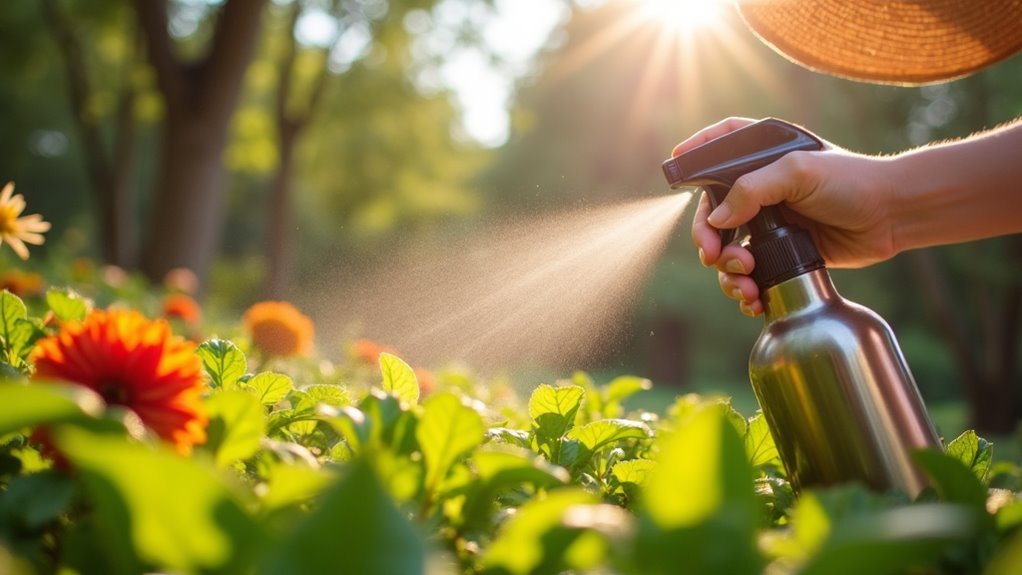
Three strategic application techniques will maximize your apple cider bug spray’s outdoor application coverage and effectiveness.
First, create your effective natural solution by mixing equal parts apple cider vinegar and water in a spray bottle. Add several drops of liquid dish soap to help the mixture adhere better to surfaces and disrupt insect navigation.
Apply during cooler temperatures in early morning or late afternoon to prevent evaporation. Focus on high-traffic pest areas like doorways, windows, and garden perimeters where insects commonly gather. This targeted approach guarantees your bug repellent reaches critical zones.
Reapply every few hours, particularly after rain or watering, to maintain the protective barrier. Consistent reapplication keeps your natural defense system active against unwanted pests.
Target Pests and Expected Results
Apple cider vinegar’s acidic properties make it particularly effective against specific household and garden pests that rely heavily on scent-based navigation.
This natural solution disrupts their ability to locate food sources and establish trails, making it one of the most reliable insect repellents available.
You’ll find apple cider vinegar effective at keeping these common pests away:
- Ants – Disrupts scent trails and deters colony movement
- Fruit flies – Acts as both repellent and trap ingredient
- Aphids – Mix equal parts with water for garden application
- Mosquitoes – Repelling mosquitoes through strong odor interference
- General household insects – Safe and effective contact killer
Regular application guarantees keeping those pesky bugs at bay while maintaining a chemical-free environment for your family.
Safety Considerations for Family and Pet-Friendly Use
Unlike commercial pesticides that pose serious health risks, apple cider vinegar offers a remarkably safe alternative for households with children and pets. This chemical-free solution won’t harm your loved ones when properly prepared.
Mix your homemade bug spray with equal parts water to prevent skin irritation. Always perform a patch test on a small area before widespread application to guarantee no adverse reactions occur.
Store your apple cider vinegar spray in glass containers within cool, dark spaces to maintain effectiveness and prevent chemical leaching. The non-toxic nature means it’s safe for use around family and pets throughout your home.
Remember to reapply every few hours for best results, giving you peace of mind while protecting against unwanted pests naturally.
Storage Tips and Shelf Life Guidelines
You’ll want to store your homemade apple cider bug spray in a cool, dark place using a dark glass spray bottle to protect it from light and heat exposure.
When stored properly, your spray will maintain its effectiveness for 6-12 months, though this drops to 3-6 months in warmer conditions.
Check your stored spray regularly for unusual odors, color changes, or separation—these signs indicate it’s time to make a fresh batch.
Proper Storage Methods
Once you’ve prepared your homemade apple cider bug spray, proper storage becomes vital for maintaining its effectiveness. The way you store your spray directly impacts its shelf life and potency.
Follow these storage guidelines to maximize your spray’s performance:
- Use a dark glass spray bottle to protect contents from light exposure that can prevent degradation of active ingredients.
- Store in a cool, dark place like a pantry or cabinet away from heat sources.
- Label the spray bottle with preparation date to track freshness over time.
- Shake the bottle gently before each use to verify ingredients are well mixed after separation.
- Replace every 6-12 months when stored properly, or sooner in warm conditions.
Proper storage prevents your spray from losing potency and helps reduce effectiveness issues.
Maximum Effectiveness Duration
The effectiveness of your apple cider bug spray diminishes over time, making it essential to understand how long you can expect ideal pest-repelling performance. When stored properly in cool, dark conditions, your apple cider bug spray maintains its shelf life for 6-12 months.
However, warmer storage environments reduce this timeframe to 3-6 months as heat degrades the active ingredients responsible for pest control.
You’ll need frequent reapplication every few hours for maximum effectiveness, particularly after rain or high humidity exposure. Using airtight containers prevents contamination and preserves potency longer.
Monitor your spray’s appearance and smell regularly—significant changes indicate it’s time to create a fresh batch. Proper storage practices directly impact how well your homemade solution repels unwanted insects.
Frequently Asked Questions
Does Apple Cider Vinegar Work as Bug Repellent?
Yes, you’ll find apple cider vinegar works as a natural bug repellent. Its acetic acid disrupts insects’ smell, deterring ants, fruit flies, and mosquitoes when you spray equal parts vinegar and water.
What Is the Best Homemade Bug Spray for a House?
You’ll want to mix equal parts apple cider vinegar and water, then add several drops of liquid dish soap. For enhanced effectiveness, include peppermint or eucalyptus essential oils in your homemade solution.
How to Keep Bugs Out of Your House Without Pesticides?
You can keep bugs out by sealing food in airtight containers, cleaning regularly, eliminating standing water, and using natural deterrents like vinegar sprays that disrupt insects’ scent trails and navigation systems.
How Do You Make Apple Cider Vinegar Mosquito Repellent?
You’ll mix equal parts apple cider vinegar and water in a spray bottle. Add a few drops of citronella or eucalyptus oil for enhanced effectiveness. Shake well before applying to skin and clothing.
In Summary
You’ve now got everything you need to create your own chemical-free bug spray using apple cider vinegar. Remember to test the spray in small areas first, reapply regularly for best results, and store it properly to maintain effectiveness. This natural solution won’t eliminate every pest, but it’ll greatly reduce unwanted insects while keeping your family and pets safe from harsh chemicals.

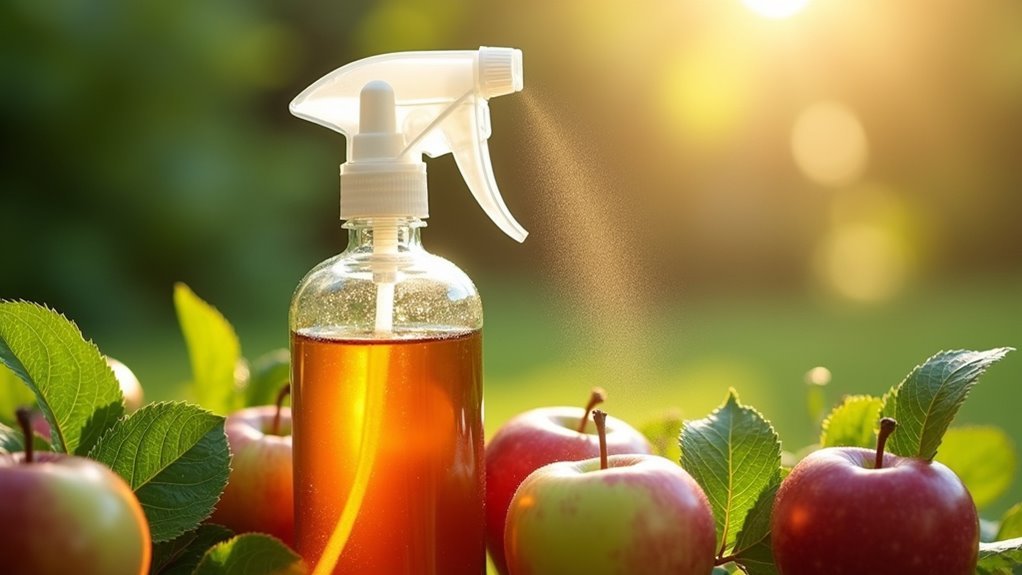

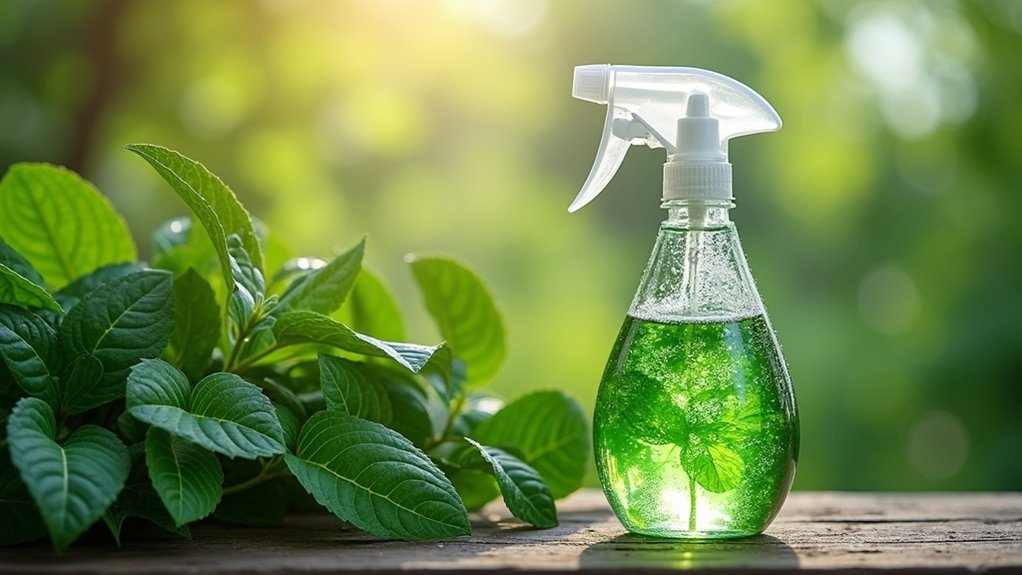
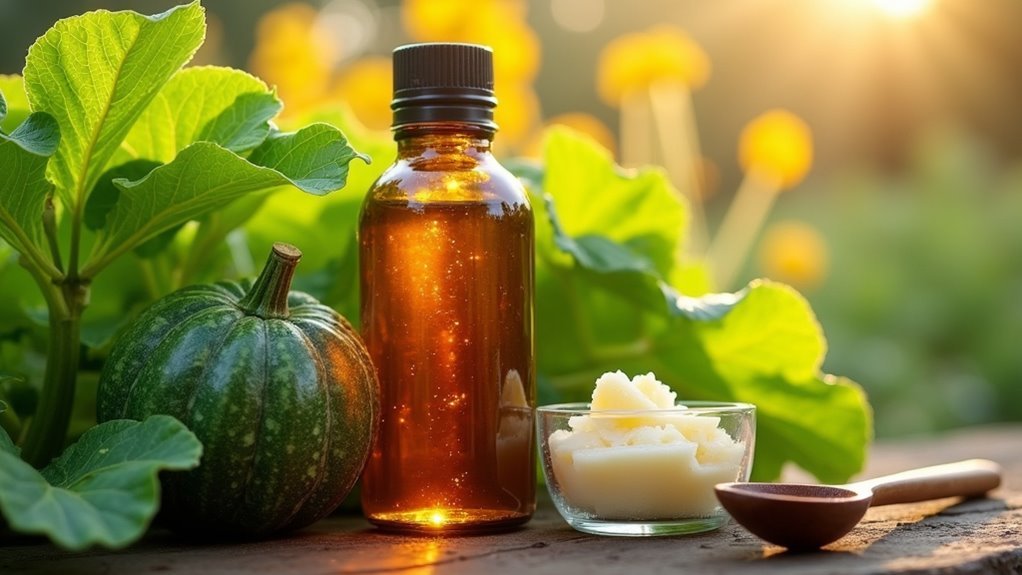
Leave a Reply